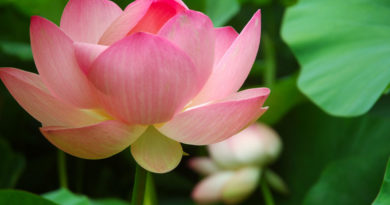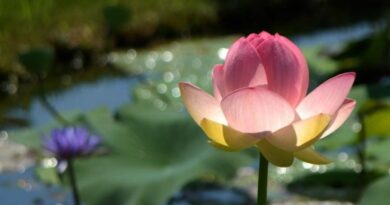A TECHNIQUE OF LIVING – 2. THE PRACTICE OF RELAXATION
IT has been said that life is too serious to be taken seriously. We might enlarge on this by saying that life is so serious and so unsatisfactory that by becoming resistant and tense about it we merely make it more serious. In other words, tension increases the seriousness of things.
Not everyone shares this view that life is so serious and unsatisfactory. For some, the continual search for personal gratification is relatively successful, and they feel that they’re getting something better than the usual fifty-fifty mixture of pleasure and displeasure, a little more rest than effort, a little more happiness than sorrow. This is all they expect and they are reasonably satisfied with it.
There are others who get something worse than the average of fifty-fifty mixture of happiness and sorrow; life deals out to them less pleasure than pain, and they must give out more than they receive. They must take great efforts and enjoy little rest, and their sorrow outweighs their happiness. Their unremitting efforts to extract form life more than it can yield create a general state of tension that makes life still more serious.
Those of us who are tense, it seems, outnumber those who are relaxed; but few realize just how tense they are and just how this tension is spoiling things for them.
How does tension arise in the first place? To begin with you must realize that tension is necessary under certain conditions. If you’re in a dangerous situation the natural reaction is to tense your muscles; your whole physical mechanism is then geared up for escaping or fighting. The reaction has been instrumental in survival and the processes of tensing the muscles together with the physical changes that take place throughout the body are necessary in special situations.
But this is where the trouble lies. You can’t fully turn off the tension; you find that you’re always tense, even when there is no occasion for it.
Thus you see that while tension is useful under some conditions, it’s not necessary for twenty-four hours a day and seven days a week.
Before we go any further we must ask ourselves this: what do we mean by tension? We know that by muscular tension we mean a state in which some of our muscles are partly contracted and the nerves controlling them are ready to produce a further contraction at an instant’s notice.
But what do we mean by mental tension? Our minds control the nerves that lead to our muscles, so that if these nerves are in a continual state of readiness it’s because our minds are acting as if they were continually expecting some emergency suddenly to develop.
Your mind is in a state of alertness due to anxiety, resentment, or self-assertion. In some situations the alertness is commendable and useful, but when long sustained it’s generally pointless, without an object, and – worst of all – beyond the immediate control of your consciousness. It’s controlled from mental level inaccessible to consciousness rather than by the higher conscious functions of your mind.
The precipitating causes of your inward tension lie in the outer world, it’s true; they lie in your need to earn a living, in your family obligations, and in the demand made upon you to compete for prestige; but the real causes lie in yourself. The real causes of tension lie, firstly, in the anxiety you feel when something you value is threatened; secondly, in the resentment you build up towards those that threatened your valued things and your self-importance; and thirdly, in the need you feel constantly to assert yourself.
Let’s look at the three basic causes of tension one at a time. The first is anxiety, and this arises when anything you value is threatened. The more things you desire the more vulnerable you make yourself to the onset of anxiety. While anxiety is related to various emotional factors, concern for your own well-being or for the well-being of your near ones and possessions is its main foundation. In Buddhist psychology this concern arises from self-centred desire, which embraces not only the grosser manifestations of desire such as avarice and stinginess but all of its less obvious forms.
The second basic tension-causing mental factor is resentment. Since in the full course of his life the average person meets so many annoyances and frustrations, he builds up an aversion towards the things and people that seemingly cause them.
Because this aversion – in its mild as well as in its intense manifestations – is as a general rule neither fully expressed nor fully resolved, it remains to simmer and smoulder in the form of resentment.
The third of the basis mental causes of tension is the false need you feel constantly to assert yourself, to gain and retain prestige, and to maintain a sense of self-importance even at the expense of self-deceit. You can easily see it in others when it appears in its blatant forms, but as it exists in yourself you’re seldom aware of it. In Buddhist psychology it’s called delusion, since the self you constantly assert is unreal when understood in ultimate terms; and all your tendencies towards self-assertion (as well as your feelings both of self-importance and of inferiority) are all parts of this deeply rooted delusion.
Thus we see that, according to the Buddha-doctrine, all mental happiness springs from self-centre desire, aversion, and delusion. As we’re considering them here as tension-causing factors, desire is expressed as anxiety, aversion is expressed as resentment, and delusion is expressed as self-assertion.
Now until you’ve developed self-understanding, you’re not fully aware of the real causes of your anxiety; you’re not completely conscious of your resentment, nor again do you really know the full extent of your self-assertion. Thus you’re unable properly to deal with unwanted tension.
Tension manifests in the body as well as in the mind. Thus arises the need to deal with the problem of tension not only at the higher level of the mind but also at the lower level of the body, particularly in the voluntary muscles.
A Buddhist exercise called poster mindfulness can be readily adapted for the purpose of bodily relaxation. The essence of the adapted practice of posture mindfulness is to give special attention to the various muscle-groups of the body, searching for unwanted tension in the muscles and consciously relaxing them. You can use posture mindfulness for purposes of relaxation whenever your mind is free from other concerns, but perhaps the best time is before you settle down to sleep each night.
Having assume a comfortable posture, you let the focus of consciousness move slowly several times from one side to the other across your forehead and eyebrows, keeping in mind the idea that you want the muscles concerned to relax or to become limp instead of tight. You can assist the effect by saying mentally “relax, relax” during the process.
You may not at first recognize any tension in the forehead and eyebrows, for it may have become so habitual that it feels quite normal. Even so, the quite application of consciousness to the muscles will do a great deal towards removing any tension that does exist there.
Then you allow the focus of consciousness to move over and around one eye, across the eyelid, and then behind the eye where so many delicate muscles are located. Then you take the attention across to the other eye and move it around, across, and behind it.
Tension is often more evident in the mouth and jaws than elsewhere. Thus when you move the focus of consciousness to your mouth and jaws you may become definitely aware of your tension, manifested by clenched teeth and a firmly set mouth. You slowly apply increased mindfulness to the muscles concerned, and the idea of relaxation which you’re all the while keeping in mind will cause the tension to disappear or at least to diminish.
Now you apply the same degree of attention to your tongue, relaxing it as well as you can and allowing it to become as limp as possible. It may be necessary to spend more time on the mouth, jaws, and tongue than on other parts of the body.
Next you can carry the centre of attention down to the neck, spiralling around and up and down several times. You then do the same to the muscles of your shoulders.
From the shoulders you take the focus of consciousness down one arm, spiralling around and along it and searching for tense muscles. When you reach the hand, it’s best to take the back of the hand and then each finger one at a time, trying to become aware of each one separately.
You then let your attention flow on to the thigh of the same side, moving down in a spiral to the knee, the lower part of the leg, and the foot.
From there you can move across to the other foot, spiralling up that leg and thigh to the hand of that side. For many of us it’s not necessary to spend a great deal of time on the muscles of the legs and feet, since the tension doesn’t usually appear there as much as in other muscle groups.
With the hands, however, it’s different, for here there may often be considerable tension. In its extreme form this may show itself in clenched fists.
Therefore, after the focus of attention has travelled down one leg and up the other, when it reaches the hand of the second side it’s wise to slow up the movement of consciousness and to give individual attention to each finger as before, to the back of the hand, and to the wrist, and then to spiral the focus of consciousness up the arm to the shoulder.
You’ve now encircled the body from the head down one arm and one leg to the foot, and back again via the foot, the le and the arm on the other side. There remain the muscles of the chest and the abdomen. You therefore give attention to the sensations in the upper part of the chest, moving the focus of attention across the chest, around the back, and again across the chest, spiralling downwards until you reach the muscles of the abdomen.
This completes the basic adaptation of posture mindfulness for the purpose of muscular and nervous relaxation. You may vary it, abbreviate it, or extend it, according to your needs and conditions; but in any form the practice just described is a good foundation for the removal of body tension and, to a certain extent, for the easing of mental tension also.
*
Apart from Buddhism, you find that both Eastern and Western systems of relaxation employs techniques which are basically the same as this method.
It is generally considered that in the best form of the practice, you should lie, not in bed, but on the floor, flat on the back and with the arms lying limply by the sides, for the non-yielding floor allows you to detect tense muscles more readily than does the soft bed. The only reason why this muscular relaxation method has been described as being practised whilst in bed rather than when lying on the floor is because, for most of us, the day is so full of other things that it’s not until we go to bed that we can find the time to carry out the practice.
*
Now while the mindful and systematic application of consciousness to tense muscles is generally effective in relaxing them, they may soon afterwards become just as tense again. What you must do, then, is to do consciously what for so long you’ve been doing subconsciously. You must consciously and deliberately tense the muscles so as to make the tension-process accessible to consciousness and to remove it from the realm of subconscious activity.
Therefore you proceed to stiffen of tense the muscles concerned, mindfully feeling the sensations of the tension, and then slowly release the tension, all the while giving attention to the feeling of decreasing tension and increasing relaxation. By this means the conscious aspects of the mind gradually take over functions which were hitherto subconsciously controlled.
Starting with your forehead and eyebrows, you consciously frown and slowly relax. Then you consciously open your eyes widely and stare at nothing, and slowly close them and relax the muscles around them. You grit your teeth and then slowly relax your jaws by attending to the muscles of your face, especially those around your mouth. Similarly you tense your tongue and relax it. When you come to your neck, you stiffen it, move your head rigidly forwards, backwards, and from side to side a little, afterwards slowly letting it become as limp as possible. You then hunch your shoulders forward, draw them stiffly back, and then slowly relax them. And so on throughout other muscle groups.
You may have to carry out this alteration of contracting and relaxing a muscle group many times in the one session before it becomes effective. Sometimes, in the early stages of learning the relaxation technique, it’s better occasionally to devote a whole session to only one set of muscles.
In this connection the device of verbalised thought is very helpful. In using this device, you repeat mentally the name of the part of the body whose muscles you are attending to and also tell yourself mentally when you are tensing then and when you are relaxing them. Thus you say mentally: “Jaws …tense …relax. Cheek …tense …relax. Mouth …tense …relax.” This verbalising process helps to keep out unwanted trains of thoughts.
*
A system (of non-Buddhist origin) of assisting to relieve mental tension consists of visualising black objects or shapes. Thinking of blackness is the nearest you can ordinarily get to thinking of nothing, and thus to the exclusion of unwanted or disturbing thoughts.
In makes little difference what kind of black image you form; you can imagine a black disc, and you can make this disc grow larger an larger, or you can let it change to an octagon, a square, and a triangle. Or again, you can imagine that you’re painting everything in the room black, stage by stage.
So long as blackness is the predominant idea, the process will help to relax the mind.
Practical work
For this period your work consists of establishing the practice of relaxation as a habit. Resolve to undertake the practice on at least four occasions a week; or – particularly if you feel a special need – once a day. If you can carry out the practice whilst lying on the floor, all the better, otherwise you can adapt it for use when in bed before settling down to sleep at night. Try to keep ten of twenty minutes for this purpose.
Use the self-contract method of self-discipline and impose on yourself some small penalty whenever you fail to keep to your resolution.








